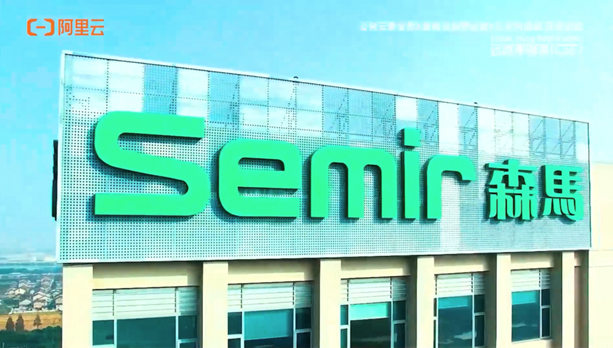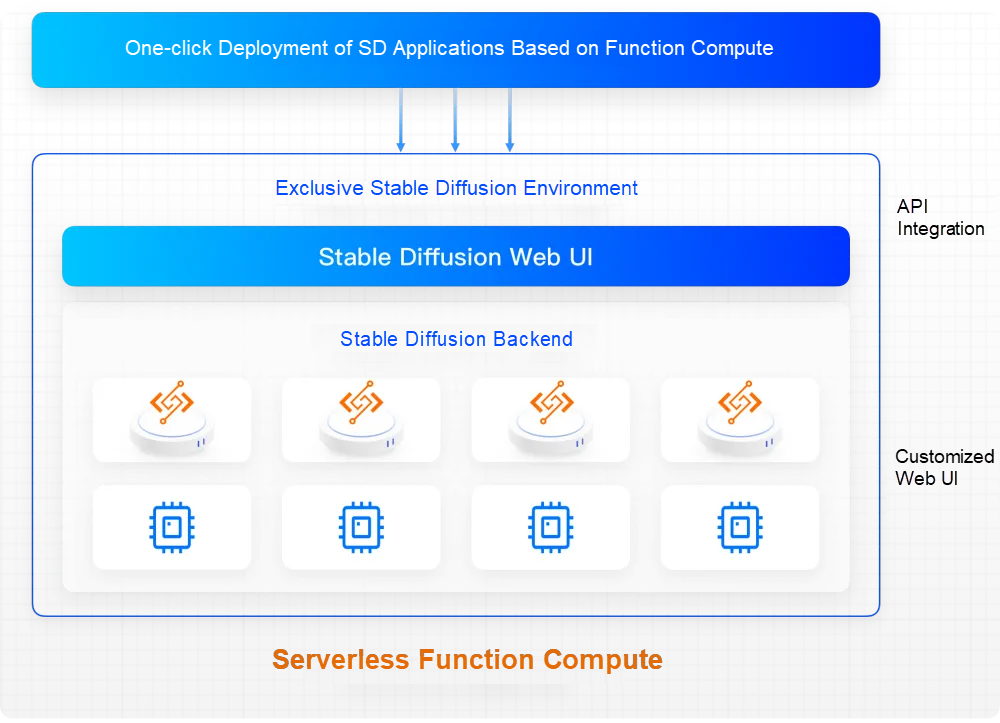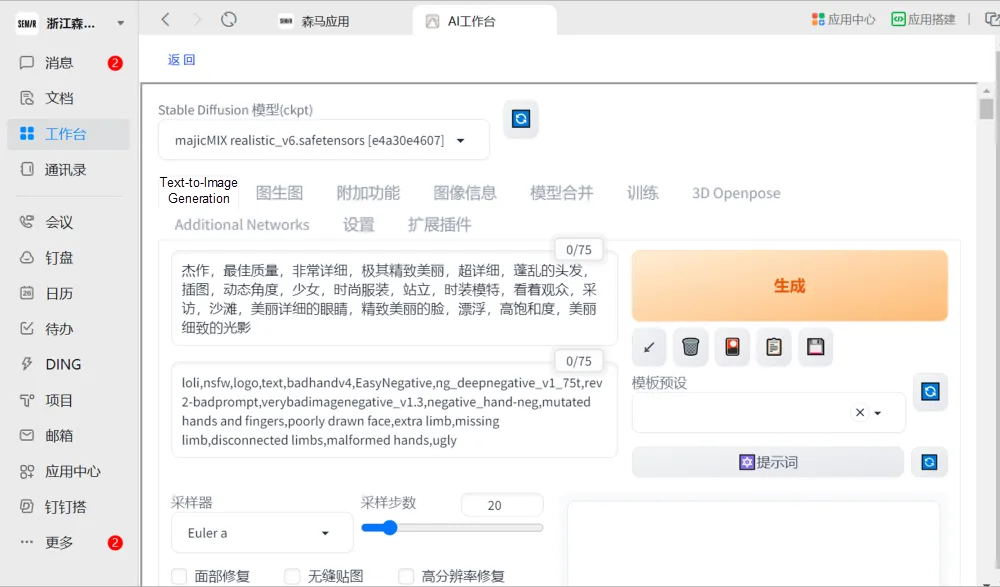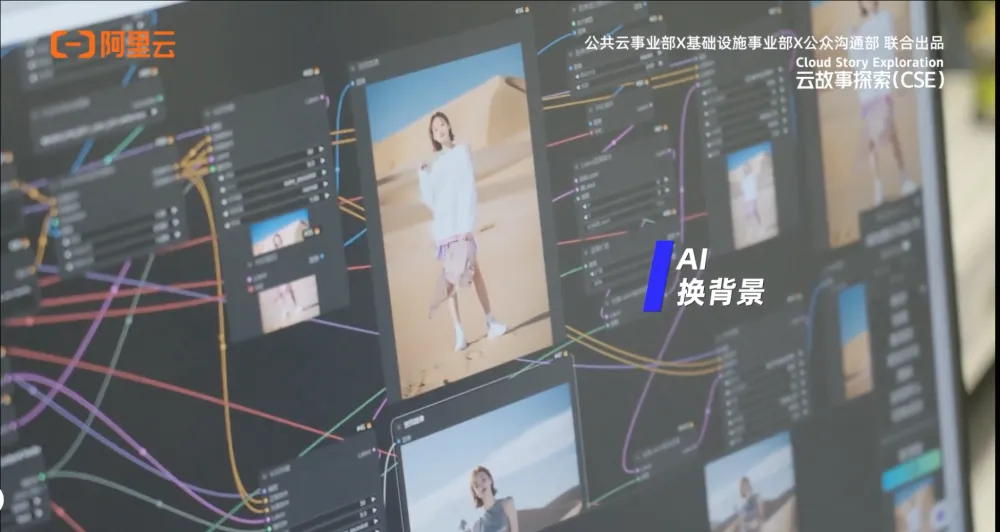
Function Compute has helped Semir, a leading fashion brand in China, overcome multiple challenges in the early stages of its AI projects, including the excessively long decision-making cycle, the high cost of self-managed GPU clusters, and the difficulty of model deployment. Function Compute provides the Stable Diffusion model to facilitate the development and deployment of AI inference applications.
How to empower our business with innovative projects is very important for Semir. Function Compute has helped us address many challenges in the process of applying AI to our business scenarios, including the storage of GPU computing resources, high procurement costs, and high technical barriers. With Function Compute, we are one step ahead of other industry partners, able to make informed decisions quickly, and experience the exciting changes brought by new technologies to clothing design and marketing in the clothing industry.
- Lin Jianxia, Head of Innovative Business R&D of Semir Digital Center
2023 is widely regarded as the first year of the AIGC boom, with many awed by the creativity of numerous AI models. All industries are looking forward to the infinite potential promised by AI technologies. As a key computing power provider in the era of AIGC, Alibaba Cloud helps enterprises reap the "dividends" of AI technologies at lower cost and higher efficiency.
At the beginning of 2023, Semir sought to quickly integrate AI technologies deep into its core business processes to realize an intelligent upgrade of the entire process from product design, manufacturing, and marketing, to after-sales service in the clothing industry. In this article, we'll explore how Semir, an enterprise that has accompanied the growth of several generations in China, uses Function Compute to transform the traditional clothing industry with AI technologies and how it improves production efficiency with the help of AIGC in various scenarios.
Since its founding in 1996, Semir has been dedicated to offering young people fashion products for various daily scenarios, celebrating an affordable, stylish and comfortable lifestyle. Over the past 27 years, Semir has kept pace with the times and has evolved to become one of the leading brands in China's fashion sector. In addition to adult clothing, Semir also owns a range of children's clothing brands such as Balabala, which has become a leader in the children's apparel market in China.
By 2022, Semir's e-commerce business had achieved gross merchandise value (GMV) exceeding RMB 12 billion, with over 8,000 physical stores and over 2,000 franchisees across more than 400 cities in China. While continuously iterating and expanding its business, Semir has also achieved leapfrog development from informatization to digitalization.
Rapidly evolving AIGC technologies continue to optimize the effects of text-to-image models. Meanwhile, open-source projects represented by Stable Diffusion (SD) are booming, making text-to-image generation one of the hottest application fields of large models. Semir intends to quickly integrate AI technologies deep into its core business processes to realize an intelligent upgrade of the entire process from product design, manufacturing, and marketing, to after-sales service in the clothing industry. Like many other enterprises, Semir encountered many difficulties in the early stages of its projects.
Tasks that rely heavily on complex computing models, such as text-to-image generation, have extremely high requirements on hardware, especially in terms of GPU computing power. In addition, model inference services require building the corresponding AI applications. This necessitates various resources, including CPU computing power, storage, and high-speed networking, each playing an important role in the efficient running of the project.
For innovative projects that are still in the exploration stage, project owners hope to verify value output at the lowest cost. However, given the expensive GPU computing power on the market and the long lead time for building data centers, it is undoubtedly challenging to accurately estimate and decide on huge hardware investments. Apart from the huge financial burden, uncertainties in the procurement, deployment, maintenance, and future upgrades of hardware equipment and the hiring of O&M professionals can cause unnecessary costs and delays that hinder the progress of projects.
Eager to jump on the AI bandwagon, many enterprises initially considered building self-managed GPU clusters and deploying large models locally. However, besides high-end GPU servers, other essential investments include storage, networking, and other infrastructure, all of which require a substantial upfront outlay of funds. Even more daunting is the post-deployment operations and maintenance (O&M). The costs arising from continuous operation, associated with power consumption, heat dissipation systems, and hiring of maintenance personnel, among other things, make self-managed GPU clusters a less appealing choice for enterprises. The same is true for a fashion brand like Semir.
Stable Diffusion is an open-source AI image generation model. For enterprises requiring high stability and efficiency, this open-source model alone cannot solve the difficulties in user isolation and resource allocation. A typical example is that when multiple people are using the Stable Diffusion WebUI concurrently, problems such as a long queue, stuttering, and mutual interference during model switching can occur. These problems will result in poor user experience, reduced efficiency, and interruptions to the creative work of designers.
Function Compute is a fully managed, event-driven computing service. With Function Compute, users do not need to purchase or manage infrastructure such as servers. Instead, they only need to upload their code or images. Function Compute allocates computing resources, runs business requests or tasks in an elastic and reliable manner, and provides features such as log query, performance monitoring, and alerting. Function Compute is a typical serverless computing service. It allows enterprises and developers to focus on their business and frees them from resource maintenance operations. Function Compute offers flexible scaling based on demand and the pay-as-you-go billing method.
As early as two years ago, Function Compute began deploying GPU computing power to provide users with scalable, pay-as-you-go, and highly virtualized GPU computing power clusters. Currently, Function Compute is compatible with mainstream inference GPU models, such as T4 and A10. With virtualization segmentation, Function Compute supports the configuration of a minimum of 1 GB of GPU memory for a single instance. More GPU models will be supported in the future.
After AIGC went rival last year, demand from enterprises and developers for the power of AIGC-driven innovation exploded. However, when exploring and implementing AIGC solutions, enterprises and developers face pain points such as high GPU computing costs and complex AI application construction. To address these pain points, Alibaba Cloud's Function Compute team has been dedicated to creating a simple and elegant platform for developing and deploying AI inference applications in alignment with industry trends. Function Compute has hosted a range of open-source models in Serverless Application Center, such as SD and ComfyUI.
Take the SD model as an example. It supports quick deployment and can be up and running within minutes upon deployment in the production environment. Function Compute has also optimized the open-source SD model by providing an SD model management interface, separating the frontend and backend of the SD WEB UI, and providing highly encapsulated flexible APIs, so that users can consume SD model services in various forms. In addition, Function Compute is deeply integrated with ModelScope. Many models on ModelScope can be quickly deployed to Function Compute for use.
Apart from model hosting, Function Compute has planned AI Runtime, which allows users to quickly turn their models into API services. Function Compute also allows users to create images and deploy models online. Most importantly, regardless of how Function Compute is used, its elastic, maintenance-free, and pay-as-you-go GPU computing power allows for flexible and cost-effective hosting of AI inference applications. The combination of Serverless Application Center and Function Compute enables developers to deploy and use AIGC applications from ground zero, creating their own AIGC environments.
Function Compute helps users create their own AIGC environments
Benefit 1: Quick to get started and easy to use
Benefit 2: Business-centric and lower operational and maintenance costs
Benefit 3: Automatically scalable GPU computing resource pool with low cost of use
Alibaba Cloud Function Compute is just the right solution to the problems faced by Semir. Leveraging the capability of quick Stable Diffusion deployment provided by Function Compute, Semir is able to rapidly apply the SD model to multiple scenarios. To let employees tap into the advantages of SD, Semir has integrated the model into their internal DingTalk workbench to provide most employees with access to a customized SD page. This ensures that the model and plugins are predefined for ready use, thereby simplifying the use of the native SD model. For professional designers, however, Semir provides the native SD environment to allow them to tailor the model and plugins to diverse needs.


Semir's AI Workbench
After more than half a year of exploration, Semir has expanded its deployment of the Function Compute-based SD text-to-image model from the initial two business units to a total of 13 groups across six business units. The AIGC capabilities provided by the SD model have improved service design efficiency and streamlined workflows. During this period, Semir has gathered extensive user feedback from frontline designers. For example, some find that the native SD page is still too complex, and some suggest introducing AI workflows to improve image creation efficiency.
To address these issues, Semir and the Function Compute team have begun further collaboration to develop an improvement plan:
The collaboration between Function Compute and Semir has also enriched the technological accumulation of the technical teams of both parties in the field of AIGC applications.
In the early stages of design, a fashion designer typically spends two or three days creating a design draft. This involves finding inspiration, sketching, coloring, finalizing the design, and submitting it for review. Now, with the help of AI technologies, the same process can take as little as 30 seconds. Designers simply need to describe their ideas to AI which then quickly generates visuals. This way, AI technologies revolutionize the approach to creating best sellers.
In the visual shooting stage, the making of a poster often requires the diligent work of a professional team. Specifically, an exquisite advertising poster requires the professional shooting skills of a photographer and a model wearing appropriate makeup done by a makeup artist, as well as clothing and accessories carefully selected by a fashion stylist. The shooting site is also important. Simply put, the whole process cannot be done without the combined efforts of multiple roles.
With AI technologies coming into play, the visual shooting process has undergone significant changes. Previously relying on an entire team for shooting and production, the same process can now be done by a single person with the help of AI. Through model training, one can easily achieve realistic looks on models or dress forms, and generate various backgrounds for product posters as needed. This greatly simplifies design and marketing workflows and accelerates the transformation of ideas into final products.

Ms. Lin Jianxia, head of Innovation Business R&D of Semir Digital Center, shared with us the potential applications of AI technologies in Semir's business:
• Using AI algorithms to analyze massive amounts of user data and fashion trend information to achieve accurate prediction and quick response to changes in youth fashion, helping designers create clothes that are tailored to the needs of the market.
• Using AI to optimize supply chain management to improve production efficiency, reduce inventory risk, and ensure that products reach consumers faster and at better prices; using AI to implement personalized recommendations and intelligent customer service to improve the shopping experience and increase user stickiness.
• Using AI to aid in data analysis and gain real-time insights from market feedback to provide a scientific basis for making strategic branding decisions.
In the future, the innovative project team of Semir Digital Center will keep an open mind and actively explore ways to integrate AI technologies seamlessly into the clothing industry, and strive to make breakthroughs in AI adoption in the shortest possible time, leading the industry in the digital and intelligent transformation.
This year, Semir plans to deploy this cutting-edge AI drawing technology at its stores to allow customers to create custom T-shirts the way they want. To provide technical support for this initiative, the Function Compute team has applied serverless technology to GPUs and proposed the new vision of "enabling everyone to create their own AIGC environment." This approach significantly reduces the cost of trial and error and the technical barrier for users to experiment with AI and allows users to concentrate on business development, freeing them from concerns about the operations and maintenance of the underlying resources.
CloudFlow: Streamlined Development Makes It Easier to Build Applications on the Cloud
Themepica Technology Enhances Data Processing Efficiency with Serverless
99 posts | 7 followers
FollowAlibaba F(x) Team - June 22, 2021
Alibaba Cloud Native - July 20, 2023
Alibaba F(x) Team - September 30, 2021
Alibaba Clouder - December 31, 2020
Alibaba F(x) Team - June 20, 2022
Alibaba F(x) Team - September 16, 2021
99 posts | 7 followers
Follow Alibaba Cloud for Generative AI
Alibaba Cloud for Generative AI
Accelerate innovation with generative AI to create new business success
Learn More Tongyi Qianwen (Qwen)
Tongyi Qianwen (Qwen)
Top-performance foundation models from Alibaba Cloud
Learn More Function Compute
Function Compute
Alibaba Cloud Function Compute is a fully-managed event-driven compute service. It allows you to focus on writing and uploading code without the need to manage infrastructure such as servers.
Learn More AI Acceleration Solution
AI Acceleration Solution
Accelerate AI-driven business and AI model training and inference with Alibaba Cloud GPU technology
Learn MoreMore Posts by Alibaba Cloud Serverless